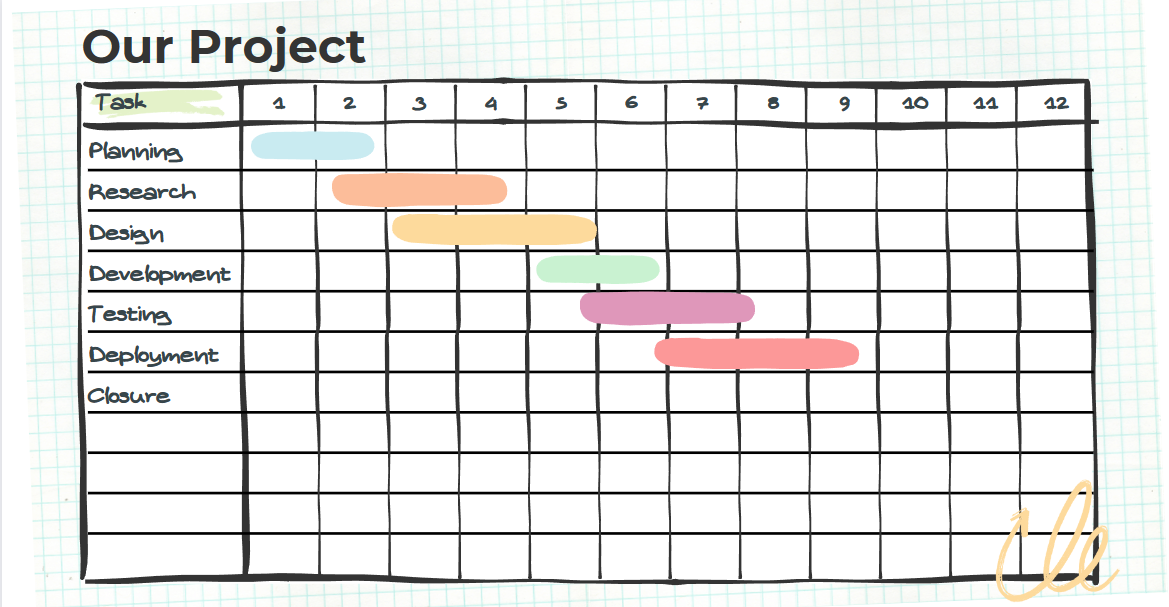Our thoughts
A Project Manager's Guide to Timelines

Giving you the keys to an efficient and successful project timeline.
November 21, 2023
Creating a timeline is essential for effective project management. A timeline sets clear expectations upfront for all parties involved in a project and serves as the benchmark of accountability, providing structure to what would otherwise become chaotic. While it may not result in pure chaos, a project without a timeline can quickly become hectic and disorganized. We all appreciate the smooth sailing brought by the calming winds and peaceful waters of a well-structured timeline.
1. Create a Visual
I am a simple man; I use an Excel spreadsheet to put together my Gantt charts. Although there are numerous software options available, with some specific to Gantt charts and others serving as Task Management software like Clickup, I prefer Excel. This is because, when sharing it with clients and adding it to my weekly reports, simplicity and familiarity often outweigh the features of specialized tools.
2. Space it into Sprints
Break the timeline into sprints that best fit the project duration. Sprints, which are common in project management, are focused, time-boxed intervals dedicated to planning, executing and reviewing tasks. I default to two-week sprints, but the choice between monthly or weekly sprints depends on the project's length. Ensure each sprint has a start date and denote its length, sparing collaborators from mental math.
3. Denote Resources
You don't want to reach a critical point in a project only to realize you lack a necessary license or content that can't be produced in a day. While internal teams may understand project nuances and needs, this understanding doesn't always translate to outside vendors or customers. Note the due dates of specific needs from external groups to prevent surprises and reduce the risk of unexpected delays.
4. Anticipate Risk
A golden rule in project management is to underpromise and overdeliver, especially with timelines. Cover your bases by highlighting potential risks that could adversely affect the timeline. Build in some padding, especially if certain team members tend to overestimate their task completion speed. Everyone appreciates a project completed on time, and nobody complains if it's finished ahead of schedule.
5. Note Holidays and Time Off
This may seem obvious, but it is important to mark holidays on your timeline. People often take well-deserved time off around holidays. Call attention to these periods, inquire about potential time off, and adjust the timeline accordingly.
6. Update as You Go
Life gets busy, and predicting the future is impossible. Regularly update the timeline and communicate changes with all involved parties. Certain deadlines must be met, so communicate them and discuss how potential risks could affect each deadline and the overall timeline.
Thank you for coming to my TED Talk.
Related blogs

Highlights from NACS 2024
by High Monkey | April 25, 2024
A week of uniting experts, empowering innovation, and redefining collaboration in Dallas!
Read more
How to Make Microsoft Teams Collaboration Enjoyable
by Seth Moline | February 06, 2024
Helping you turn chaos into collaboration with 4 practical tips for enjoyable Microsoft Teams usage.
Read more
4 Ways Engaging Content Drives Digital Success
by Cole Schlotthauer | January 11, 2024
Learn how engaging content works wonders to grow your digital presence.
Read more